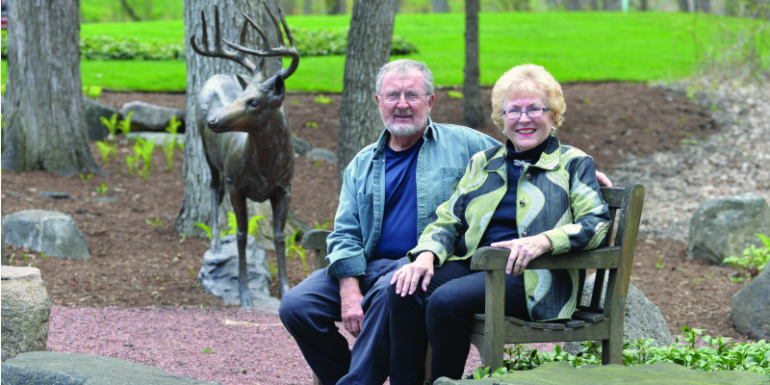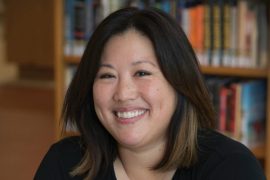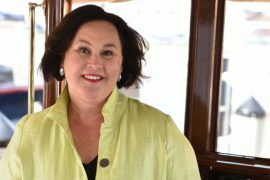By Anne Morrissy | Photography By Holly Leitner
In 1972, Jay Brost had Just taken the ultimate leap. He left his job at a metal manufacturing company in Walworth to found his own company that focused on the material of the future: plastics. Just five years earlier, Americans had watched Dustin Hoffman’s Benjamin Braddock receive famous advice in Mike Nichols’ cult classic film The Graduate. The line delivered from a smug businessman: “I just want to say one word to you. Just one word: plastics,” evoked laughter from millions of movie-goers. But for Brost, who had a background in chemistry and petrochemicals, plastics were no joke.
In the early 1960s, freshly graduated from college, Brost took a job working in Baton Rouge, Louisiana, for a military contractor before eventually moving to Janesville to work for the venerated and established Parker Pen Company. While at Parker Pen, he gained valuable experience in thermoplastic manufacturing and began experimenting on his own.
When he left Parker Pen for the job at the metal manufacturing plant, Brost learned more about the world of miniature components, particularly the many tiny parts that go into the production and manufacturing of automobiles. By 1972, he was ready to combine these two knowledge bases to design and patent an auto emissions valve, which would become the basis for a newly formed company he called Miniature Precision Components Inc., or MPC.
MINIATURE PRECISION COMPONENTS INC.
Brost initially founded MPC Inc., out of his home in Walworth. “I was able to develop the functioning and testing of the products right in my garage,” he remembers. “By our second or third products, we had to put them in grapefruit juice cans, and I just filled my garage up.” Although the first product Brost patented was in fact a miniature component, subsequent products made by his newly formed company expanded in size. “I tagged the company MPC, but the second product that we made no longer was miniature,” he explains. “The fifth product was as big as a breadbox. By then, we got into the injection molding and extrusion of thermoplastics.”
Thermoplastics are the form of plastic that can be heated to a specific temperature, poured into a mold and then cooled to a solid state again. It’s a technology that has been used to make everything from military equipment to Tupperware, and as predicted by The Graduate in 1967, it is big business. Brost’s MPC Inc., focuses on automotive components, and by the 1970s, government regulation of the automotive industry and the environment had created a niche market. “The products that we put on automobiles were based on federal requirements for emission controls, air conditioning controls and ignition controls,” he explains. “The government created the market by having federal mandates on the way engines had to perform.”
By 1974, the little company that Brost founded in his garage had grown large enough to require a manufacturing plant. He decided to build it in what is now the Walworth Industrial Park in Walworth. “I could see with the proper vision and planning, there would be plenty of room for a company in an area like Walworth to grow fantastically in [the thermoplastics] industry,” he says. “The excellent workforce around Walworth and the source of management people around Walworth was just incredibly good.” The company was so successful that Brost continued to expand operations throughout the next three decades, adding more plants in Wisconsin, as well as expanding to Tennessee, Michigan, Arizona, Mexico and eventually even Japan. “The whole thing was based on a series of fortunate events,” he says with characteristic humility.
Today MPC Inc., employs over 1,500 people at nine plants around the world.
DISCOVERING A NEW PASSION
Almost 30 years after founding MPC Inc., Jay Brost decided to retire from day-to-day operations and focus on a newly discovered hobby: bronze sculpting. “About the turn of the 21st century, I turned the company over to my four kids and now they’re all members of the Board of Directors,” he explains. “I was a wannabe artist all my life. So I never really retired, I just went into sculpture.”
One of the first monumental sculptures that he completed was a statue of Chief Big Foot, the Potawatomi chief whose village was located on the shores of Geneva Lake. To complete the statue, Brost turned to his wife Barbara for help. “Barbara is a graduate of Michigan State University and her academic training is in sculpture,” he explains. “She’s really the brains of the operation.” Married in the year 2000, Jay and Barbara Brost have gone on to create dozens of monumental bronze sculptures together, many of which are on display in public spaces throughout the Lake Geneva area.
Their Chief Big Foot sculpture, for example, is prominently displayed in Reid Park on Fontana’s lakefront. You can also find a version of him at Big Foot High School and the Big Foot Country Club. The Fontana Municipal Beach displays another prominent Brost sculpture called “The Surfer,” a kinetic, life-sized statue of a windsurfer that the Brosts made in conjunction with local artist Ben Thompson. Other public sculptures include a statue of Saint Benedict himself at St. Benedict Catholic Church in Fontana, a statue called “The Gardener” at Horticultural Hall in Lake Geneva, and a bust of Yerkes Observatory founder George Ellery Hale at the Yerkes Observatory Museum. Many of the Brosts’ sculptures are located throughout the Walworth Industrial Park near the headquarters of MPC Inc., as well. [See sidebar.]
ART FOR EVERYONE
In addition to the prominence of the Brosts’ art in public spaces, several of their creations are in private collections and art galleries as far away as Mexico and Japan. But Brost says they create bronze sculptures not for any kind of acclaim but because it’s a passion project. “If I wanted to make money, I’d go back to working,” he says. His favorite aspect of sculpting is that “it gives you mindfulness … all you think about is what you’re doing. It makes for enjoyable living.”
This spring, two new Brost sculptures were unveiled in the area. “A Time to Read,” a sculpture of a child reading with his dog, was placed at the Walworth Memorial Library. And a new sculpture was recently dedicated at the Open Arms Free Clinic of Walworth County in Elkhorn. “[The sculpture] is a person sitting down, kind of a nondescript person—not male or female, not young or old—holding one arm up, holding a dove,” explains Sara Nichols, executive director of Open Arms.
“It’s such a deep, meaningful type of emotion,” she says passionately. “Father Dan Sanders was the catalyst to get [Open Arms] going. He shared his vision and people responded so fast and in such great amount, and it feels like this spirit continues to live in the amazing talents of people in the community. We are so grateful for this original piece of art.”
The Brosts continue to be prolific sculptors. But when asked if his new career has any similarities to the multi-million-dollar company he founded, Jay Brost doesn’t think so. “The molds we make in automotive thermoplastics extrusions are space-age technology,” he says. “The molds you make to produce the bronze sculptures: that technology hasn’t changed since 6,000 B.C. We’re making them the same way they did when they made Zeus, the first bronze sculpture. Bronze is a material that is there forever. That’s why I like it. It will be there for a long time.”
WHERE TO SEE THE BROSTS’ SCULPTURES IN THE GENEVA LAKES AREA:
CHIEF BIG FOOT —Fontana’s Reid Park, Big Foot High School, Big Foot Country Club
COUGAR —Walworth Industrial Park
WHITE TAIL DEER —Walworth Industrial Park
“THE RUNNING BEARS”— Walworth Industrial Park
“BALD EAGLE ON A WORLD GLOBE”—Walworth Industrial Park, MPC plant in Prairie du Chien, MPC plant in Richland Center
“THE SURFER”—Fontana Municipal Beach
FROG —Little Foot children’s park in Fontana, Fontana grade school as a 100-year time capsule
“CIRCLE OF FRIENDS” (completed with fellow artist Ron Eckert)— Walworth County Alliance for Children, Elkhorn
“THE GARDENER” (dedicated to the Lake Geneva Country Club)— Lake Geneva Horticultural Hall
STUDENTS—Fontana Library
“A TIME TO READ”—Walworth Memorial Library
“OPEN ARMS”—Open Arms Free Clinic of Walworth Country, Elkhorn
SAINT BENEDICT—St. Benedict Catholic Church, Fontana
FILLY HORSE—Walworth Industrial Park
“BLUE HERONS IN FLIGHT”— Walworth Industrial Park, Walworth and Burpee Museum of Natural History, Rockford
BUST OF GEORGE ELLERY HALE— Yerkes Observatory Museum, Williams Bay





